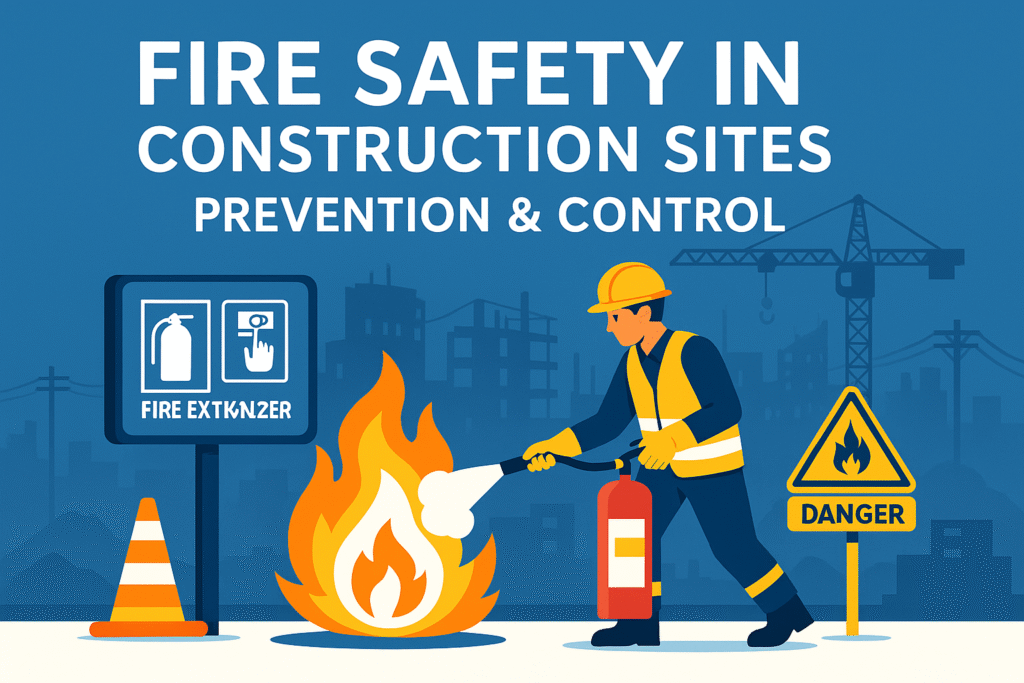
Fire Safety in Construction Sites – Prevention & Control
Construction sites contain a high number of fire hazards—flammable materials, welding activities, electrical equipment, fuels, and temporary structures. Without proper fire safety measures, even a small spark can lead to major fires, property damage, or fatal accidents.
This article provides a complete guide on fire prevention, hazard control, emergency preparedness, and best fire safety practices for construction projects.
Common Fire Hazards at Construction Sites
Understanding fire hazards is the first step in preventing them.
Hot Work Activities
Welding, cutting, grinding, brazing, and soldering produce sparks and high heat, making them one of the leading causes of fires.
Temporary Electrical Installations
Construction sites rely on temporary power setups which may include:
- Overloaded circuits
- Damaged extension cords
- Exposed wiring
- Improper grounding
These greatly increase fire risks.
Flammable & Combustible Materials
Materials commonly found on sites include:
- Fuel (diesel, gasoline)
- Paints & thinners
- Adhesives
- Timber
- Packaging materials
Improper storage leads to rapid fire spread.
Smoking in Unauthorized Areas
Open flames and cigarettes can quickly ignite combustible materials.
Faulty Machinery & Overheating
Poor maintenance can lead to:
- Electrical short circuits
- Fuel spills
- Overheated motors
Gas Cylinders & LPG
Leaked gas from cylinders or hoses can cause explosions and flash fires.
Fire Prevention Measures at Construction Sites
Fire accidents can be significantly reduced by following structured preventive measures.
Implement a Fire Safety Management Plan
A fire safety plan should include:
- Site fire risks
- Preventive measures
- Firefighting equipment
- Training requirements
- Emergency contacts
- Evacuation procedures
This ensures everyone knows their responsibilities.
Maintain Good Housekeeping
Poor housekeeping increases fire load.
Ensure:
- Waste is removed daily
- Flammable materials are minimized
- Access paths remain clear
- Combustible scrap is segregated
A clean site burns slower and is safer to evacuate.
Safe Storage of Flammable Materials
Follow essential rules:
- Store fuel and chemicals in ventilated, fire-rated containers
- Keep quantities to the minimum required
- Ensure proper labeling
- Maintain distance between ignition sources and storage areas
Use Fire-Resistant Materials and Barriers
Temporary structures should:
- Be made from fire-resistant materials
- Use fire-rated partitions
- Have proper insulation for heating equipment
Ensure Electrical Safety
To prevent electrical fires:
- Inspect cables daily
- Avoid overloading outlets
- Use GFCIs
- Keep electrical panels covered
- Engage only licensed electricians
- Replace damaged equipment immediately
Control Smoking on Site
Create strict “No Smoking Zones” and provide designated smoking areas away from combustible materials using:
- Signboards
- Fireproof ashtrays
- Regular supervision
Train Workers in Fire Safety
Training helps workers:
- Identify fire risks
- Use fire extinguishers
- Raise alarms
- Follow safe procedures
A trained worker reacts faster during emergencies.
Hot Work Safety Measures
Hot work is a high-risk activity that requires strict controls.
Implement a Hot Work Permit System
Before hot work starts:
- Inspect the area
- Remove flammable materials
- Assign fire watchers
- Ensure extinguishers are available
- Inspect equipment
A Hot Work Permit ensures all hazards are addressed.
Assign a Fire Watcher
The fire watcher must:
- Stay during and 30 minutes after hot work
- Watch for sparks or smoldering materials
- Be trained in using fire extinguishers
This prevents delayed fire ignition.
Create Safe Hot Work Areas
Safety precautions include:
- Non-combustible blankets
- Fire-resistant barriers
- Spark containment systems
- Adequate ventilation
Fire Protection Equipment in Construction Sites
Construction sites must have easy-to-access firefighting equipment.
Fire Extinguishers
Types required:
- Water extinguisher – wood, paper, debris
- CO₂ extinguisher – electrical fires
- Foam extinguisher – flammable liquids
- Dry chemical extinguisher – multipurpose
Place extinguishers:
- At every 15 meters
- Near hot work zones
- Close to storage areas
- On each floor level
Fire Hose Reels
Used for larger fires, installed at strategic points in buildings under construction.
Smoke Detectors & Alarms
Temporary fire detection systems alert workers quickly.
Fire Blankets
Useful for hot work, small fires, and personal protection.
Emergency Preparedness at Construction Sites
Preparedness reduces panic and ensures fast, coordinated responses.
Evacuation Plan
Include:
- Escape routes
- Assembly points
- Emergency signage
- Floor plans
Fire Drills
Conduct fire drills:
- Every 3–6 months
- For all shifts
- With all contractors
Emergency Response Team (ERT)
ERT should be trained in:
- Firefighting
- First aid
- Rescue procedures
- Alarm operation
Fire Control Measures
If a fire breaks out, these steps help minimize risks:
Raise the Alarm Immediately
Activate alarm systems or shout “Fire! Fire!”
Shut Off Power and Fuel Sources
Stop electrical supply, generators, and fuel valves.
Use the Correct Fire Extinguisher
Match extinguisher type to the fire category.
Evacuate and Call Emergency Services
Never attempt to fight large or spreading fires.
Conclusion
Fire safety at construction sites requires continuous awareness, proper planning, and strict compliance with prevention and control measures. By managing hot work, electrical setups, flammable materials, and emergency preparedness, construction sites can significantly reduce fire-related risks.
Remember: Prevention is better than firefighting — and preparation is the key to survival.
For checklist and templates visit The HSE Tools.
Personal Protective Equipment – PPE in Construction
Electrical Safety in Construction Areas
How to Conduct a Construction Site Safety Audit
Fall Protection Measures at Construction Sites
Safety Precautions for Excavation and Trenching Work
Frequently Asked Questions (FAQs)
What causes most fires on construction sites?
Hot work, electrical faults, fuel spills, and poor housekeeping.
How often should fire extinguishers be inspected?
Monthly visual checks and annual professional servicing.
Do construction sites need fire alarms?
Yes, temporary fire detection systems are highly recommended.
What is a Hot Work Permit?
A document ensuring hot work is performed safely with all necessary precautions.
Who is responsible for fire safety on site?
Contractors, supervisors, workers, and the Fire Safety Officer share responsibility.